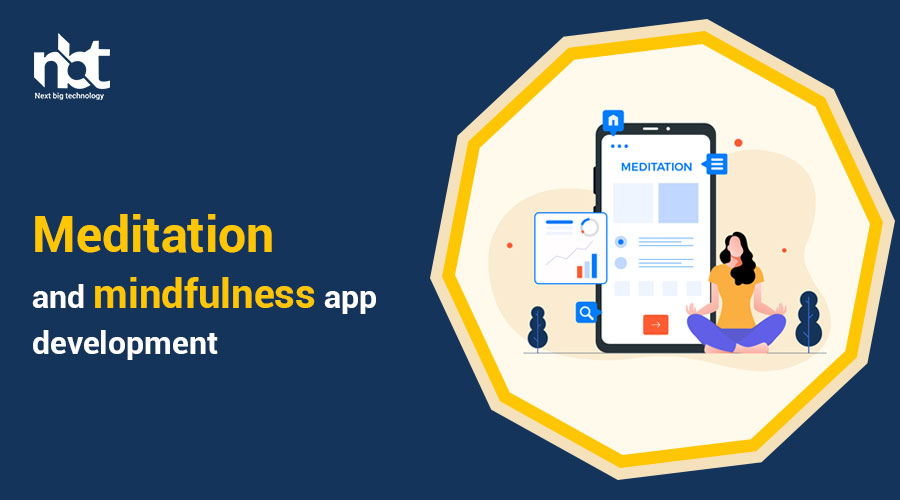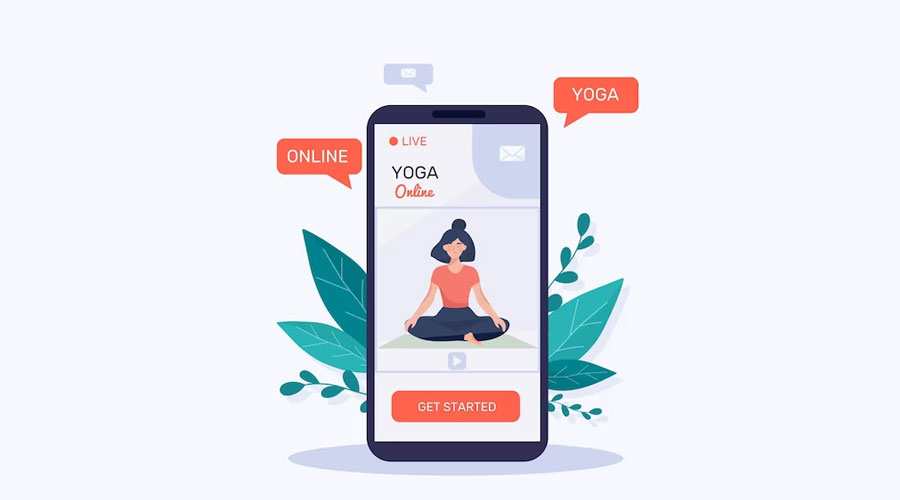Table of Contents
Introduction to Meditation and Mindfulness Apps
In today’s fast-paced and digitally connected world, stress and anxiety have become ubiquitous companions for many. People are constantly juggling their personal and professional lives, often neglecting their mental well-being. However, a digital revolution is underway, and it’s not just about productivity apps or social media platforms. Meditation and mindfulness app development is a rising trend, offering a lifeline to those seeking inner peace and balance in their lives.
Meditation and mindfulness apps are the digital key to unlocking the age-old practices of calming the mind, cultivating mindfulness, and achieving inner serenity. As our lives become increasingly chaotic, there’s a growing recognition of the need to take a step back, breathe, and regain control over our mental and emotional well-being. These apps provide a gateway to these practices, making them accessible to people of all ages and backgrounds.
In this article, we’ll delve into the world of meditation and mindfulness app development, exploring the significance of these apps, the key features that make them indispensable, the development process behind creating them, and how they contribute to the well-being of millions around the globe. From stress reduction to enhanced focus and improved emotional health, these apps are transforming lives in a profound way. Join us as we embark on a journey through the serene landscape of meditation and mindfulness in the digital age.
Benefits of Meditation and Mindfulness Apps
let’s explore some additional benefits of meditation and mindfulness apps:
1. Accessibility Anytime, Anywhere: Meditation and mindfulness apps offer the convenience of practice at any time and in any place. This accessibility is particularly valuable for individuals with busy schedules or those who may not have access to in-person meditation classes or retreats. Users can engage in mindfulness and meditation exercises from the comfort of their homes, during work breaks, or while traveling.
2. Reduced Healthcare Costs: The regular practice of mindfulness and meditation has been linked to improved physical and mental health. For individuals dealing with chronic conditions, such as hypertension, chronic pain, or anxiety disorders, the use of these apps can lead to reduced healthcare costs. By addressing underlying stress and emotional factors, users may experience fewer medical visits and lower medication requirements.
3. Increased Emotional Resilience: Meditation and mindfulness apps help users develop emotional resilience. By becoming more aware of their thoughts and emotions, individuals can learn to cope with challenging situations more effectively. This emotional resilience can have a positive impact on one’s ability to handle stress, anxiety, and adversity in daily life.
4. Enhanced Creativity and Problem-Solving: Mindfulness practices promote divergent thinking, allowing users to think more creatively and approach problem-solving with a broader perspective. By calming the mind and reducing mental clutter, these apps can improve cognitive flexibility and lead to more innovative solutions in various areas of life, including work and personal projects.
5. Improved Time Management: Consistent mindfulness practice through apps can help users become more present and focused in their daily tasks. As a result, they may find it easier to manage their time effectively, prioritize tasks, and avoid distractions. This improved time management can boost productivity and reduce feelings of being overwhelmed.
6. Stress Reduction in the Workplace: Many individuals experience stress in the workplace. Meditation and mindfulness apps can provide employees with tools to manage stress during the workday. This can lead to increased job satisfaction, reduced absenteeism, and improved overall productivity in corporate settings.
7. Better Decision-Making: Mindfulness practice encourages users to make decisions from a place of clarity and inner wisdom. By reducing impulsive reactions and enhancing self-awareness, these apps help individuals make more considered and rational decisions in both personal and professional life.
8. Enhanced Mind-Body Connection: Meditation and mindfulness practices foster a deeper connection between the mind and body. Users often report greater body awareness and sensitivity to physical sensations. This improved mind-body connection can contribute to better physical health, such as reduced muscle tension and improved posture.
9. Support for Recovery: Mindfulness apps are increasingly used in addiction recovery programs. They assist individuals in managing cravings and emotional triggers, which are often central to addiction issues. By offering mindfulness techniques, these apps can play a vital role in supporting individuals on the path to recovery.
10. A Sense of Community and Belonging: Many meditation apps provide a community platform where users can connect with like-minded individuals, share their experiences, and feel a sense of belonging. This virtual community can be particularly valuable for those who may not have access to in-person meditation groups or who seek a sense of camaraderie on their mindfulness journey.
Key Features of Meditation and Mindfulness Apps
let’s delve deeper into some additional key features of meditation and mindfulness apps that can enhance the user experience and make these apps more effective:
- Progressive Meditation Programs: Beyond standalone meditation sessions, some apps offer structured, progressive programs. These programs guide users through a series of meditations, gradually increasing in complexity and depth. This feature helps users grow their practice and experience the benefits of meditation over time.
- SOS Sessions: For those moments of acute stress or anxiety, SOS sessions are invaluable. These are short, quick meditations or mindfulness exercises designed to provide immediate relief. They’re like a digital breathing space for users when they need it most.
- Offline Downloads: Users may not always have access to a reliable internet connection. Offering the option to download meditation sessions for offline use ensures that users can meditate wherever they are, whether it’s on a remote hike or during a flight.
- Reminder Customization: Apps often include reminder settings that allow users to set specific times for meditation. The ability to customize the frequency and timing of reminders is essential for creating a personalized meditation schedule.
- Stress Assessment: Some apps integrate stress assessment tools that track physiological indicators like heart rate or skin conductance. These measurements can help users understand the impact of their meditation practice on their stress levels.
- Breathing Exercises: While guided meditation is a primary focus, breathing exercises are a fundamental component of mindfulness. Apps that offer various breathing exercises, such as diaphragmatic breathing or box breathing, provide users with versatile tools for managing stress and anxiety.
- Integration with Wearable Devices: To enhance the user experience, some meditation apps can sync with wearable devices like smartwatches or fitness trackers. This integration allows users to monitor their meditation and mindfulness progress alongside other health metrics.
- Nature Sounds and Backgrounds: Creating a serene environment for meditation is vital. Apps often include a selection of nature sounds, ambient music, or customizable background images to help users find the perfect setting for their practice.
- Sleep Stories and Meditation Playlists: To assist users in falling asleep or staying asleep, some apps offer sleep stories or meditation playlists that create a calming bedtime routine.
- Mood and Emotion Tracking: Beyond traditional progress tracking, some apps encourage users to record their emotional states before and after meditation sessions. This feature helps users understand how their practice affects their mood and emotional well-being.
- Gratitude Journals: Practicing gratitude is a proven way to enhance overall well-being. Some apps include digital gratitude journals where users can jot down things they are thankful for each day.
- Meditation Challenges and Rewards: Gamification elements such as challenges, badges, and rewards can motivate users to stay consistent with their practice. Completing challenges or reaching milestones can be incredibly satisfying.
- Guided Yoga Sessions: Yoga and meditation often go hand in hand. Some apps offer guided yoga sessions, providing a holistic approach to physical and mental well-being.
- Language and Localization: To cater to a global audience, many apps are available in multiple languages and offer localized content and practices that align with cultural preferences.
- Scientifically Backed Content: Some meditation apps collaborate with experts and researchers to provide content rooted in scientific research. Users may trust these apps more when they know the practices are evidence-based.
- Parental Controls: For families, apps with parental controls ensure that children are exposed to age-appropriate content and use the app safely.
- Mental Health Resources: In recognition of the importance of mental health, some apps provide links to crisis hotlines, mental health resources, or the ability to connect with mental health professionals when needed.
- Integration with Health Apps: For a comprehensive view of well-being, integration with health apps can provide users with data on how meditation and mindfulness practices influence their overall health, such as heart rate variability or sleep patterns.
Incorporating these additional features into your meditation and mindfulness app can create a more comprehensive and engaging user experience, making it a go-to tool for those seeking mental well-being and stress relief.
Technical Aspects of App Development
let’s dive deeper into the technical aspects of meditation and mindfulness app development.
1. Cross-Platform Development:
To reach the widest audience, consider using cross-platform development frameworks like React Native or Flutter. These technologies allow you to develop a single codebase for both iOS and Android, saving time and resources.
2. User Authentication:
Implement secure user authentication methods such as OAuth 2.0 or JWT (JSON Web Tokens) to protect user data and ensure that only authorized users can access the app’s content.
3. Audio and Video Streaming:
Meditation and mindfulness apps heavily rely on audio and video content. Implement efficient streaming capabilities to deliver high-quality content with minimal latency. Use codecs like AAC for audio and H.264 for video to ensure compatibility with various devices.
4. Data Storage:
Choose the appropriate database system to store user data, meditation history, and preferences. Use a robust database like SQLite or Firebase Realtime Database for offline access and real-time data synchronization.
5. Offline Access:
Implement caching mechanisms to enable offline access to previously downloaded meditation sessions. This is essential for users who want to meditate in locations with limited or no internet connectivity.
6. Push Notifications:
Utilize push notifications to remind users of their meditation sessions and encourage consistent practice. Implement push notification services like Firebase Cloud Messaging (FCM) or Apple Push Notification Service (APNS) for iOS.
7. Payment Integration:
If you choose a subscription-based monetization model, integrate payment gateways like Stripe or PayPal to handle in-app purchases securely. Ensure that these transactions comply with App Store and Google Play Store policies.
8. Personalization Algorithms:
Develop algorithms that analyze user behavior, meditation preferences, and progress to suggest personalized meditation sessions. Machine learning and data analytics can be used to improve the accuracy of these recommendations over time.
9. Security and Data Privacy:
Prioritize the security of user data. Implement data encryption and ensure that your app complies with data privacy regulations, such as GDPR for European users. Regularly update your security measures to protect against evolving threats.
10. Performance Optimization:
Optimize the app’s performance to ensure a smooth and responsive user experience. Minimize loading times, reduce app size, and implement code splitting techniques to keep the app running smoothly.
11. API Integration:
Integrate third-party APIs for features like weather forecasts (for outdoor meditations), location services (for local meditation events), and social media sharing. Ensure these integrations enhance the user experience.
12. Testing and Quality Assurance:
Thoroughly test the app on various devices and screen sizes to identify and fix any bugs. Consider automated testing tools to streamline the testing process, and involve real users for beta testing to gather valuable feedback.
13. App Store Optimization (ASO):
Invest in ASO to improve the app’s visibility on app stores. This includes optimizing keywords, creating appealing app store listings, and encouraging positive reviews and ratings.
14. Continuous Improvement:
After the app’s launch, monitor user feedback, track analytics, and gather user data to make continuous improvements. Regularly update the app with new content, features, and bug fixes to maintain user engagement.
15. Backup and Data Recovery:
Implement a reliable backup and data recovery system to protect user data in case of unforeseen incidents, such as server failures or data loss.
16. Scalability:
Design the app’s architecture with scalability in mind. As the user base grows, your app should be able to handle increased demand without compromising performance.
Marketing and Promotion
Creating a fantastic meditation and mindfulness app is only the first step. To make your app successful, you need effective marketing and promotion strategies to reach and engage your target audience. Here are some strategies to help you get the word out and grow your user base:
- App Store Optimization (ASO): Start by optimizing your app’s presence on app stores. This involves using relevant keywords in your app’s title and description to improve its discoverability. High-quality screenshots and compelling app icons also play a crucial role in attracting potential users.
- Content Marketing: Create a blog or resources section on your app’s website to provide valuable content related to meditation and mindfulness. This can include articles, videos, and infographics. Share these resources on social media and through email marketing to build a community around your app.
- Influencer Marketing: Collaborate with influencers in the meditation and wellness niche to review and promote your app. Influencers can provide authentic testimonials and recommendations to their followers, boosting your app’s credibility.
- Social Media Marketing: Maintain a strong social media presence across platforms like Instagram, Facebook, and Twitter. Share daily tips, quotes, and snippets from your guided sessions. Run paid advertising campaigns to target specific demographics.
- User-Generated Content: Encourage your users to share their experiences with your app on social media, using specific hashtags related to your app. You can also host user challenges and feature the most compelling stories and posts on your app’s website and social media.
- Email Marketing: Collect user email addresses through your app and website, and use email marketing to keep users engaged. Send regular updates, meditation tips, and special offers to retain users and encourage them to invite friends.
- Referral Programs: Implement a referral program where users can earn rewards or premium content by inviting friends to download and use the app. This strategy can lead to exponential growth.
- PR and Media Outreach: Write press releases and pitch your app to relevant media outlets. Getting featured in articles, podcasts, or news segments can significantly boost your app’s visibility.
- Collaborations and Partnerships: Partner with wellness brands, yoga studios, or mental health organizations to cross-promote your app. Joint marketing efforts can help you tap into their existing user base.
- App Reviews and Ratings: Encourage satisfied users to leave positive reviews and high ratings on app stores. Higher ratings and positive reviews can significantly improve your app’s visibility and trustworthiness.
- Paid Advertising: Invest in paid advertising on platforms like Google Ads and Facebook Ads. These platforms offer precise targeting options, allowing you to reach users interested in meditation and mindfulness.
- Community Building: Create and maintain a strong, supportive community around your app. This can include forums, Facebook groups, or even virtual events. Engage with your community regularly to foster a sense of belonging.
- App Store Features: Submit your app for consideration to be featured by app stores. Being featured can provide a massive boost in visibility and downloads.
- User Engagement and Feedback: Continuously engage with your user base through surveys, feedback forms, and direct communication. Act on user feedback to improve your app, which can lead to higher user satisfaction and word-of-mouth referrals.
- Free Trials and Freemium Models: Offer a free trial or a freemium model to allow users to experience the app’s basic features before committing to a subscription. This can reduce barriers to entry and encourage more downloads.
- Local and Global Expansion: Consider localizing your app to reach a global audience. Translate content and ensure cultural sensitivity to make your app more appealing to users from different regions.
Remember that marketing is an ongoing process. Regularly assess the effectiveness of your strategies, track key performance indicators (KPIs), and be prepared to adjust your tactics based on user feedback and market changes. Building and promoting a meditation and mindfulness app can be a fulfilling journey, and with the right marketing strategies, you can help more people find peace and balance in their lives.
Case Studies and Success Stories
Case Study 1: Headspace – A Global Meditation App Giant
Headspace, founded by Andy Puddicombe and Rich Pierson in 2010, is one of the most prominent players in the meditation and mindfulness app industry. With its engaging content and user-friendly design, Headspace has attracted millions of users worldwide.
The Challenge: Headspace aimed to create an app that made meditation accessible to everyone, regardless of their experience level or prior exposure to mindfulness practices. The challenge was to develop an app that could effectively guide users through meditation and mindfulness techniques.
The Solution: Headspace invested heavily in content creation, collaborating with mindfulness experts to create a wide range of guided meditation sessions and mindfulness exercises. The app’s user-friendly interface and personalization options allowed users to tailor their meditation experience to their unique needs.
The Result: Headspace quickly became a household name in the meditation app space, amassing over 65 million users globally. Its success is attributed to its effective content, intuitive design, and strong community engagement. Headspace’s revenue model primarily relies on subscriptions, and it offers free content to attract new users.
Case Study 2: Calm – Redefining Sleep and Relaxation
Calm is another prominent player in the meditation and mindfulness app market, founded by Michael Acton Smith and Alex Tew in 2012. Calm is known for its unique focus on sleep and relaxation content.
The Challenge: Calm recognized the growing problem of sleep disorders and stress-related issues. They set out to create an app that not only offered guided meditation but also specialized content to help users sleep better and relax more effectively.
The Solution: Calm curated a vast library of sleep stories, sleep meditations, and relaxation content, designed to soothe the mind and promote restful sleep. The app’s beautiful, nature-inspired interface and soothing audio elements create a tranquil environment for users.
The Result: Calm has made a significant impact in the sleep and relaxation niche. It has over 100 million downloads, with users appreciating its unique content and design. Calm’s subscription model offers premium content for subscribers, with free content available for non-subscribers.
Case Study 3: Insight Timer – The Power of Community
Insight Timer, founded by Christopher Plowman in 2010, takes a different approach by focusing on building a global community of meditators.
The Challenge: Insight Timer aimed to create an app that not only offered guided meditation but also fostered a strong sense of community and connection among users.
The Solution: The app provided a platform for meditation teachers and practitioners to share their insights and guided sessions. Users can connect with others, join group meditations, and discuss their experiences in forums. Insight Timer’s library includes a vast collection of free meditations, fostering inclusivity.
The Result: Insight Timer’s community-driven approach has attracted over 30 million users worldwide. The sense of belonging and shared experiences have set it apart in the meditation app market. Insight Timer offers a mix of free and premium content, with donations and subscriptions supporting its model.
Case Study 4: Simple Habit – Micro-Meditations for Busy Lives
Simple Habit, founded by Yunha Kim in 2016, has found success by catering to the needs of individuals with busy schedules.
The Challenge: Simple Habit aimed to create an app that recognized the time constraints and stress levels of users with hectic lives. They needed to develop short, effective meditation sessions that could be seamlessly integrated into daily routines.
The Solution: Simple Habit focused on providing users with micro-meditations lasting as little as five minutes. The app’s library includes sessions for various situations, such as work stress, sleep issues, and personal development. Its sleek design and intuitive user experience made it an instant hit among busy professionals.
The Result: Simple Habit’s approach to short, targeted meditations has resonated with users juggling demanding schedules. It has gained a substantial user base and generates revenue through subscriptions that unlock premium content.
Success Stories: Transforming Lives through Mindfulness Apps
These case studies demonstrate the incredible success of meditation and mindfulness apps, each with its unique approach and value proposition. They have not only reached millions of users but have also transformed lives by providing accessible, effective, and engaging tools for mental well-being. These apps have contributed significantly to the global shift towards a more mindful and balanced way of living in the digital age.
Future Trends in Meditation and Mindfulness Apps
As technology and well-being continue to evolve, the landscape of meditation and mindfulness apps is poised for exciting changes and innovations. The following trends are expected to shape the future of these apps:
- Virtual Reality (VR) and Augmented Reality (AR) Integration: VR and AR are making their way into the world of mindfulness apps, offering users immersive and visually stimulating experiences. Users can find themselves in serene natural landscapes or engage in interactive mindfulness exercises, deepening their connection to the practice.
- AI-Personalized Meditation: Artificial intelligence (AI) will play a more significant role in these apps, allowing for even more personalized experiences. Apps will use AI algorithms to analyze user data and tailor meditation sessions to their specific needs and preferences, making the practice more effective.
- Biofeedback and Wearables: Meditation apps will increasingly integrate with wearable devices that measure biometric data like heart rate variability, skin conductance, and brainwave patterns. This real-time feedback will help users better understand the effects of their meditation practice and make adjustments accordingly.
- Mindful Gaming: Gamification elements will become more sophisticated, turning meditation and mindfulness into an enjoyable and competitive experience. Users can participate in challenges, earn rewards, and compete with friends, making meditation more engaging for a broader audience.
- Mental Health Tracking: In response to the growing demand for mental health support, meditation apps will incorporate features for tracking and managing conditions such as anxiety and depression. Users will have access to evidence-based tools and resources to help manage their mental health.
- Multi-Language and Cultural Inclusivity: Meditation and mindfulness apps will become more culturally inclusive, offering content in a variety of languages and drawing from diverse cultural and spiritual traditions. This trend aims to make mindfulness practices more accessible and relatable to people from different backgrounds.
- Corporate and Educational Integration: The importance of mindfulness in workplace well-being and education is increasingly recognized. Meditation apps will offer programs tailored for corporate wellness and educational settings, helping individuals and students manage stress and improve focus.
- Voice and Conversational Interfaces: Integrating voice-activated technologies like Amazon’s Alexa or Google Assistant will make it even more convenient for users to access guided meditation sessions and mindfulness practices simply by speaking commands.
- Advanced Analytics and Reporting: Apps will provide more in-depth analytics, allowing users to gain insights into their meditation journey over time. They can track improvements in their mental well-being and the impact of their practice on their daily lives.
- Eco-Friendly and Sustainable Practices: As environmental consciousness grows, meditation apps will adopt eco-friendly and sustainable practices in their content creation, delivery, and marketing. They may partner with eco-conscious instructors and organizations to promote well-being in harmony with nature.
- Accessible to All Abilities: Future apps will strive to make mindfulness practices accessible to people of all abilities. This includes incorporating features like closed captioning and voice recognition for individuals with hearing or visual impairments.
- Telehealth Integration: Meditation and mindfulness apps will integrate with telehealth platforms, connecting users with mental health professionals and therapists for more comprehensive support when needed.
- Offline Mode Improvement: While online access is vital for updates and content downloads, improving the offline mode will allow users to meditate without distractions, even in remote areas.
- Social Impact and Community Initiatives: Many apps may introduce community-driven initiatives to promote mental health awareness and support vulnerable populations. This may include partnerships with mental health organizations or charity programs.















